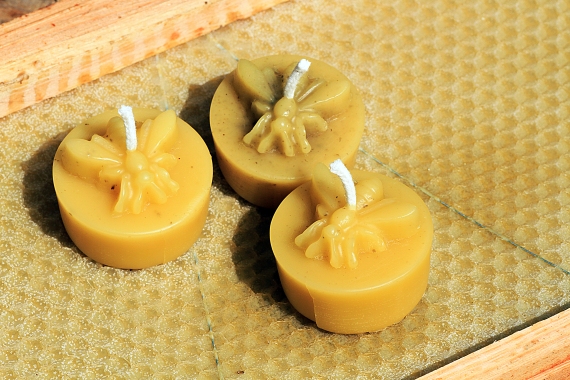Having previously written about both honey and the use of bee venom I thought it would be good to mention another product of the hive and share a bit of what I do with the wax that I accumulate from the hives. Having kept bees for several years I have ended up with quite a lot of wax from old brood frames and honey supers, cell cappings removed during the honey extraction and all those scrapings and bits of brace comb that the bees seem to build whenever they spot a little bit of space accidentally left in the hive by the careless beekeeper. The colour of the wax varies from near white cappings on the fresh honey combs to dark brown, heavily ‘propolised’, wax in the brood frames that are just a few years old.
Comb is quite bulky to store and often contains other bits and pieces from the hives so I initially melt this down to reduce the size and start the cleaning process. I use a large pan with about 2″ of water from the garden rain butt, bring it to the boil then reduce to a simmer and add my wax lumps. Bees wax has a relatively low melting point of around 62 – 64 degrees centigrade so this doesn’t take long and as it reduces the bulk, I can often get a large bucket of comb melted down in a single saucepan. I then leave this outside to cool over a couple of days, the wax ‘shrinks’ away from the sides of the pan so it is easy to remove and all the non-wax components sink to the base giving a layer of ‘crud’ which can easily be removed with a large knife and disposed of. This then leaves me with a round ‘cake’ of wax that I can store somewhere dry until I am ready to use it.
These wax cakes are then broken up using a large wooden mallet and melted down a second time in fresh rain water, I then pass the wax through a muslin cloth. To make this easier I cut a square of cloth to fit over a plastic plant pot that I have removed the base from, I attach the cloth with an elastic band to make a filter that is easy to use when I also have a large pan of hot wax to juggle. The wax is poured through this filter into containers that act as ‘moulds’ and again allowed to cool slowly. I now have wax that I consider to be clean enough for use in candle making.
In the past I have made tapered candles through ‘dipping’ wicks repeatedly into hot vats of wax but although great fun this is a very slow process, traditionally families would have got together to share a meal with all the generations helping out with this task. For the purpose of this blog though I am looking at using a candle mould to make some small candles.
Wax is best heated using a double boiler, you can buy all sorts of devices for this purpose but to be honest if you are only using small amounts a recycled tin can in a pan of boiling water works very well. I use needle nose pliers to flatten the ‘lip’ and create a pouring spout to control the wax and reduce wastage (and cleaning up afterwards).
I have also seen YouTube videos where wax is melted in a microwave in a pyrex jug and guess this works very well if you have an old microwave and jug that you don’t mind using.
The silicon mould that I am using was purchased from Thornes beekeeping suppliers, although you can buy moulds from other bee suppliers, online from specialist candle making websites and very cheaply on eBay from China. You initially need to cut a partial slit down each side of the mould to ease the removal of the candle when made, then fix elastic bands around the mould to hold it back together again, feed the wick through the base (I use a skewer for this) then attach something to hold the wick in place – a hairpin is perfect for this.
Once the wax in the double boiler has melted it is simply a case of carefully filling the mould to the top and leaving it to set, for these small bee light candles it only took around 15 – 20 minutes to set enough for removal but obviously larger candles will take significantly longer.

Pouring the molten wax into the mould (slight spillage as poured left handed whilst using the camera)
Once the candle has had time to set and been carefully removed from the mould you simply cut the wick and re-attach the hairpin ready for the next candle to be made.
We take so much for granted these days and it is cheap and easy to buy a packet of paraffin wax tea lights but these will not have had the journey from bees to hive, then cleaned and moulded into shape. There is no real value to selling them as a product as the price would never reflect the time or effort of the beekeeper in producing individual candles but there is a certain pride with putting them out as homemade when friends come round for dinner.
There are of course many other uses for bees wax, from cosmetics through to cleaning products, so I would be interested to hear from other beekeepers as to how you use your wax.
I hope to keep adding to this blog as and when time allows in 2014, thank you for taking the time to read my ramblings your continuing comments and questions – this makes it all worth while for me as the writer….
I can also be found at @danieljmarsh on twitter or British Beekeepers page on Facebook.
Dan













